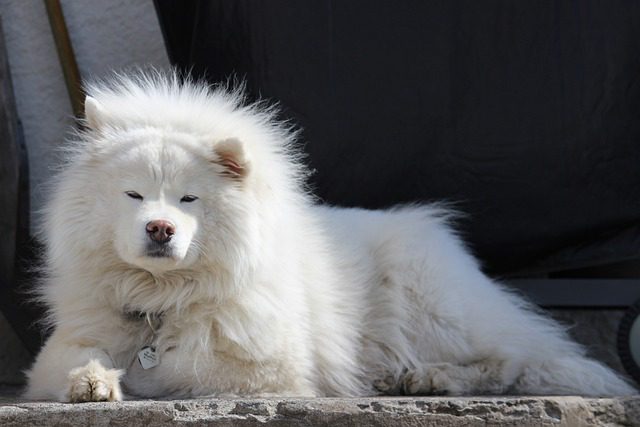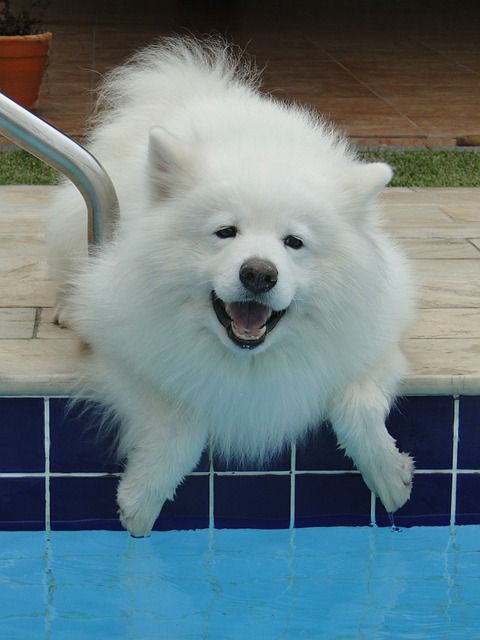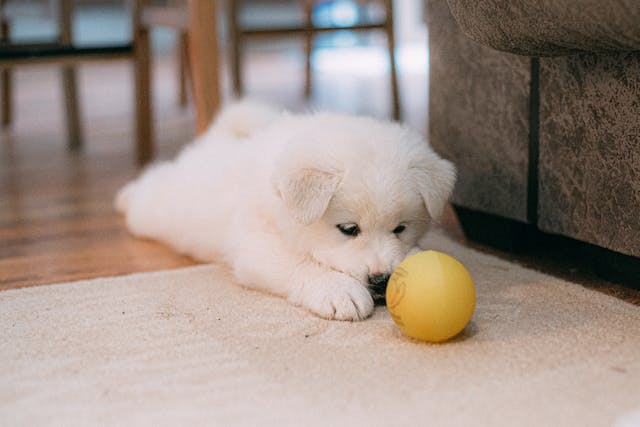Have you ever wondered if Samoyeds can handle being left alone?
Well, you’re in the right place because today we’re diving into the fascinating world of Samoyeds and their independence levels.
Whether you’re a busy bee or just curious, let’s find out if these fluffy companions can hold their own when you’re not around.
So, please grab a cup of coffee, and let’s get started!
Can Samoyeds Be Left Alone
Yes, Samoyeds can be left alone for a few hours at a time. However, they are social dogs and thrive on human companionship, so leaving them alone for extended periods is not recommended.
It’s important to provide them with mental and physical stimulation before leaving and ensure they have access to water and a safe environment.
Consider hiring a dog walker or providing them with interactive toys to keep them entertained while you’re away.
Factors That Can Affect Whether a Samoyed Can be Left Alone

When considering whether a Samoyed can be left alone, there are several factors to take into account. Here are some factors that can affect a Samoyed’s ability to be left alone:
1. Age and maturity: Young puppies generally have a higher need for attention and supervision and may not be able to be left alone for long periods. As they mature, they may become more independent and better able to handle being alone for longer periods of time.
2. Behavioral Needs: Like all dogs, Samoyeds have certain biological and behavioral needs that should be met to ensure their well-being. Dogs that do not have their needs met may display undesirable behaviors. It is important to provide them with regular exercise, mental stimulation, and social interaction.
3. Living Environment: The living environment can also impact whether a Samoyed can be left alone. Factors such as the size of the apartment or house, the availability of outdoor space, and any rules or restrictions regarding pets in the building or neighborhood should be considered.
4. Training and Socialization: Proper training and socialization play a crucial role in a dog’s ability to be left alone. Samoyeds should be trained to be comfortable with being alone and should be gradually introduced to periods of separation from their owners. Early socialization can also help them develop confidence and independence.
5. Individual Temperament: Each Samoyed has its own unique temperament and personality. Some may be more independent and better suited to being left alone, while others may be more prone to separation anxiety. It is important to consider the individual temperament of the dog when determining if they can be left alone.
6. Previous experiences: A Samoyed’s previous experiences with being left alone can also influence their ability to handle it. If a Samoyed has had negative experiences or has been consistently anxious when left alone in the past, they may have a harder time being left alone in the future.
Training a Samoyed to Be Alone

Training a Samoyed to be left alone at home can be a gradual process that requires patience, consistency, and positive reinforcement.
Here are some effective ways to train a Samoyed to be comfortable when left alone:
1. Gradual Departures and Arrivals: Start by gradually increasing the time you spend away from your Samoyed. Begin with short absences and gradually extend the duration over time. For example, you can leave the room for a minute or two initially and then gradually increase it to five minutes, ten minutes, and so on. This gradual approach helps your Samoyed become accustomed to your absence and reduces the likelihood of them becoming anxious or distressed.
2. Crate Training: Crate training provides a safe and comfortable space for your Samoyed when they are left alone. Introduce the crate gradually, associating it with positive experiences. Start by placing treats and toys inside the crate to encourage your dog to explore and enter voluntarily. Once your Samoyed feels comfortable going in and out of the crate, gradually close the door for short periods while you are still at home. Extend the time your dog spends in the crate gradually, ensuring they have enough exercise and mental stimulation before crating them for longer durations.
3. Desensitization: Many dogs become anxious or stressed when they notice specific pre-departure cues, such as picking up keys or putting on shoes, as they associate these actions with being left alone. To address this, perform these actions throughout the day, even when you’re not leaving. By desensitizing your Samoyed to these cues, you help reduce their anxiety and prevent them from becoming overly alert or worried.
4. Establish a Routine: Dogs thrive on routine and predictability. Create a consistent schedule for feeding, exercise, and playtime. Providing regular exercise and mental stimulation is particularly important for breeds like Samoyeds, as they are known for their high energy levels. A well-exercised and mentally stimulated Samoyed is more likely to be calm and content when left alone. Stick to a regular schedule to provide structure and help your Samoyed understand what to expect each day.
5. Counterconditioning: Counterconditioning involves associating a positive experience with a previously negative or anxiety-inducing situation. In this case, you want to associate your departure with positive experiences for your Samoyed. Just before leaving, give your dog a special treat or a puzzle toy filled with food that will keep them engaged. This creates a positive association with your departure and helps redirect their attention to something enjoyable. Over time, your departure will become associated with positive rewards, helping to alleviate anxiety.
6. Avoid Punishment: It’s important to avoid punishing your Samoyed for exhibiting anxious behaviors when left alone. Punishment can increase anxiety and worsen the problem. Instead, focus on reinforcing calm behavior. When your Samoyed remains calm during your absence, reward them with praise, treats, or playtime. This positive reinforcement encourages them to associate being calm with positive outcomes, reinforcing the desired behavior.
7. Exercise and Mental Stimulation: Samoyeds are an active breed that requires regular exercise and mental stimulation. Providing them with enough physical and mental activity can help reduce anxiety and restlessness when left alone. Daily walks, playtime, and interactive toys like puzzle toys or treat-dispensing toys can keep them engaged and tired. Mental stimulation can also include training sessions or engaging in activities that tap into their natural instincts, such as scent work or obedience trials.
Read more about exercising your Samoyed.
8. Positive Reinforcement: Positive reinforcement is a powerful tool in training dogs. When your Samoyed displays calm and relaxed behavior when left alone, reinforce it with rewards. Use treats, praise, and affection to reward your dog for being calm and quiet. This helps them associate being alone with positive experiences. Avoid punishment or scolding, as it can increase anxiety and create negative associations.
9. Seek Professional Help: If your Samoyed exhibits severe separation anxiety or if training alone doesn’t yield significant improvement, it may be beneficial to seek professional help. A professional dog trainer or a certified animal behaviorist can assess your Samoyed’s specific needs and provide personalized strategies. They may recommend techniques such as systematic desensitization or provide guidance on other behavior modification methods. Their expertise can be invaluable in addressing severe cases of separation anxiety.
Remember, training a Samoyed to be left alone takes time and patience. Each dog is unique, and the time it takes for them to become comfortable when left alone may vary. Be consistent in your training efforts, provide plenty of love and attention when you’re together, and gradually increase the duration of your absences. With time and positive reinforcement, your Samoyed can learn to feel secure and relaxed when left alone.
Read more about socializing your Samoyed.
Frequently Asked Questions
Can Samoyeds be left alone for long periods of time?
Samoyeds are known for their friendly and sociable nature, and they generally thrive on human company. While they can tolerate being alone for short periods, it’s not ideal to leave them alone for extended periods of time. Samoyeds are prone to separation anxiety and may become destructive or develop behavioral issues if left alone for too long. It’s important to ensure they have plenty of mental and physical stimulation, as well as regular human interaction, to keep them happy and well-adjusted.
How long can a Samoyed be left alone?
The length of time a Samoyed can be left alone depends on various factors such as their age, temperament, and training. As a general rule, it’s recommended not to leave a Samoyed alone for more than 4-6 hours at a time. Puppies and younger dogs may need more frequent breaks for potty training and exercise. It’s essential to provide them with a safe and comfortable environment, plenty of toys, and mental stimulation to keep them entertained while you’re away.
Can Samoyeds be left alone in an apartment?
While Samoyeds are generally adaptable dogs, leaving them alone in an apartment for long periods can be challenging. Samoyeds are active and energetic dogs that require regular exercise and mental stimulation. They thrive in larger spaces with access to a secure yard where they can run and play. If you live in an apartment, it’s important to ensure your Samoyed gets sufficient exercise and socialization through walks, trips to the park, or even doggy daycare to prevent boredom and destructive behavior.
Are Samoyeds prone to separation anxiety?
Yes, Samoyeds are known to be prone to separation anxiety. They are highly social dogs that form strong bonds with their human companions. When left alone for extended periods, Samoyeds may exhibit signs of distress such as excessive barking, destructive behavior, or even self-harm. It’s crucial to gradually acclimate your Samoyed to being alone and provide them with mental and physical stimulation to alleviate separation anxiety. Consider crate training, interactive toys, and leaving comforting items with your dog to ease their anxiety.
Can Samoyeds be left alone with other pets?
While every dog is different, Samoyeds generally get along well with other pets if properly introduced and socialized. However, it’s important to supervise interactions and gradually increase the amount of time your Samoyed spends alone with other pets. Some Samoyeds may display dominant or territorial behavior, especially if they have not been properly trained or socialized. It’s crucial to monitor their behavior and ensure the safety and well-being of all pets involved.
What can I do to help my Samoyed cope with being left alone?
There are several things you can do to help your Samoyed cope with being left alone. First and foremost, establish a routine and gradually increase the time they spend alone to build their independence. Provide them with plenty of mental and physical stimulation before leaving, such as a long walk or play session. Consider using puzzle toys or treat-dispensing toys to keep them occupied while you’re away. You can also leave a piece of clothing with your scent on it to provide comfort. Additionally, consider hiring a dog walker or enrolling them in doggy daycare to provide social interaction during the day.
Conclusion
In conclusion, Samoyeds are a breed that thrives on human companionship and interaction. While they can tolerate being left alone for short periods, it is essential to provide them with plenty of mental and physical stimulation when you’re away. Remember, a happy and well-exercised Samoyed is a content and well-behaved companion!

